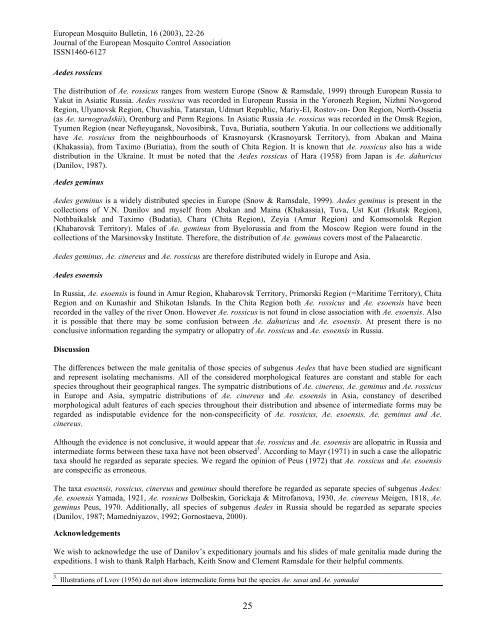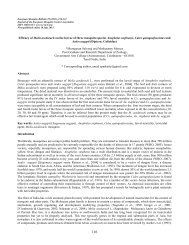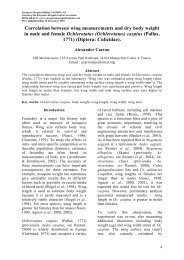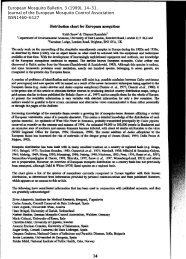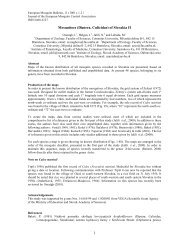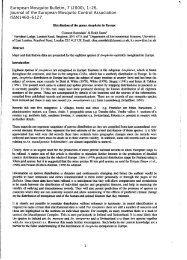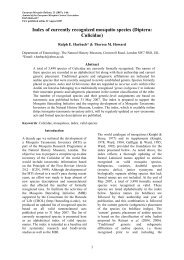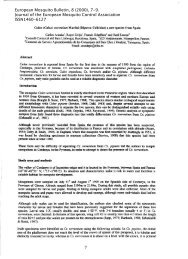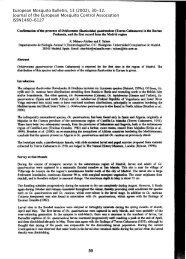<strong>European</strong> <strong>Mosquito</strong> <strong>Bulletin</strong>, 16 (2003), 22-26<strong>Journal</strong> <strong>of</strong> the <strong>European</strong> <strong>Mosquito</strong> Control AssociationISSN1460-6127<strong>Aedes</strong> rossicusThe distribution <strong>of</strong> Ae. rossicus ranges from western Europe (Snow & Ramsdale, 1999) through <strong>European</strong> Russia toYakut in Asiatic Russia. <strong>Aedes</strong> rossicus was recorded in <strong>European</strong> Russia in the Yoronezh Region, Nizhni NovgorodRegion, Ulyanovsk Region, Chuvashia, Tatarstan, Udmurt Republic, Mariy-El, Rostov-on- Don Region, North-Ossetia(as Ae. tarnogradskii), Orenburg and Perm Regions. In Asiatic Russia Ae. rossicus was recorded in the Omsk Region,Tyumen Region (near Nefteyugansk, Novosibirsk, Tuva, Buriatia, southern Yakutia. In our collections we additionallyhave Ae. rossicus from the neighbourhoods <strong>of</strong> Krasnoyarsk (Krasnoyarsk Territory), from Abakan and Maina(Khakassia), from Taximo (Buriatia), from the south <strong>of</strong> Chita Region. It is known that Ae. rossicus also has a widedistribution in the Ukraine. It must be noted that the <strong>Aedes</strong> rossicus <strong>of</strong> Hara (1958) from Japan is Ae. dahuricus(Danilov, 1987).<strong>Aedes</strong> geminus<strong>Aedes</strong> geminus is a widely distributed species in Europe (Snow & Ramsdale, 1999). <strong>Aedes</strong> geminus is present in thecollections <strong>of</strong> V.N. Danilov and myself from Abakan and Maina (Khakassia), Tuva, Ust Kut (Irkutsk Region),Nothbaikalsk and Taximo (Budatia), Chara (Chita Region), Zeyia (Amur Region) and Komsomolsk Region(Khabarovsk Territory). Males <strong>of</strong> Ae. geminus from Byelorussia and from the Moscow Region were found in thecollections <strong>of</strong> the Marsinovsky Institute. Therefore, the distribution <strong>of</strong> Ae. geminus covers most <strong>of</strong> the Palaearctic.<strong>Aedes</strong> geminus, Ae. cinereus and Ae. rossicus are therefore distributed widely in Europe and Asia.<strong>Aedes</strong> esoensisIn Russia, Ae. esoensis is found in Amur Region, Khabarovsk Territory, Primorski Region (=Maritime Territory), ChitaRegion and on Kunashir and Shikotan Islands. In the Chita Region both Ae. rossicus and Ae. esoensis have beenrecorded in the valley <strong>of</strong> the river Onon. However Ae. rossicus is not found in close association with Ae. esoensis. Alsoit is possible that there may be some confusion between Ae. dahuricus and Ae. esoensis. At present there is noconclusive information regarding the sympatry or allopatry <strong>of</strong> Ae. rossicus and Ae. esoensis in Russia.DiscussionThe differences between the male genitalia <strong>of</strong> those species <strong>of</strong> subgenus <strong>Aedes</strong> that have been studied are significantand represent isolating mechanisms. All <strong>of</strong> the considered morphological features are constant and stable for eachspecies throughout their geographical ranges. The sympatric distributions <strong>of</strong> Ae. cinereus, Ae. geminus and Ae. rossicusin Europe and Asia, sympatric distributions <strong>of</strong> Ae. cinereus and Ae. esoensis in Asia, constancy <strong>of</strong> describedmorphological adult features <strong>of</strong> each species throughout their distribution and absence <strong>of</strong> intermediate forms may beregarded as indisputable evidence for the non-conspecificity <strong>of</strong> Ae. rossicus, Ae. esoensis, Ae. geminus and Ae.cinereus.Although the evidence is not conclusive, it would appear that Ae. rossicus and Ae. esoensis are allopatric in Russia andintermediate forms between these taxa have not been observed 3 . According to Mayr (1971) in such a case the allopatrictaxa should he regarded as separate species. We regard the opinion <strong>of</strong> Peus (1972) that Ae. rossicus and Ae. esoensisare conspecific as erroneous.The taxa esoensis, rossicus, cinereus and geminus should therefore be regarded as separate species <strong>of</strong> subgenus <strong>Aedes</strong>:Ae. esoensis Yamada, 1921, Ae. rossicus Dolbeskin, Gorickaja & Mitr<strong>of</strong>anova, 1930, Ae. cinereus Meigen, 1818, Ae.geminus Peus, 1970. Additionally, all species <strong>of</strong> subgenus <strong>Aedes</strong> in Russia should be regarded as separate species(Danilov, 1987; Mamedniyazov, 1992; Gornostaeva, 2000).AcknowledgementsWe wish to acknowledge the use <strong>of</strong> Danilov’s expeditionary journals and his slides <strong>of</strong> male genitalia made during theexpeditions. I wish to thank Ralph Harbach, Keith Snow and Clement Ramsdale for their helpful comments.________________________________________________________________________________________________3.Illustrations <strong>of</strong> Lvov (1956) do not show intermediate forms but the species Ae. sasai and Ae. yamadai25
<strong>European</strong> <strong>Mosquito</strong> <strong>Bulletin</strong>, 16 (2003), 22-26<strong>Journal</strong> <strong>of</strong> the <strong>European</strong> <strong>Mosquito</strong> Control AssociationISSN1460-6127ReferencesBohart, R.M. & Washino, R.K. (1978) <strong>Mosquito</strong>es <strong>of</strong> California. Third edition. Division <strong>of</strong> agricultural sciences University <strong>of</strong>California. Berkeley, 50.Britz, L. (1983) Uber einheimische Stechmucken des Subgenus <strong>Aedes</strong> (<strong>Diptera</strong>, <strong>Culicidae</strong>). Angewandte Parasitologie 24, 152-156.Danilov, V.N. (1979) <strong>Aedes</strong> (<strong>Aedes</strong>) jamadai Sasa, Kano et Takahasi, a species new for the fauna <strong>of</strong> USSR (<strong>Diptera</strong>, <strong>Culicidae</strong>). In:Taksonomija i Ekologia Chlenistonogikh Sibiri. Novosibirsk, 149-153 (In Russian).Danilov, V.N. (1987) <strong>Mosquito</strong>es <strong>of</strong> the subgenus <strong>Aedes</strong> (<strong>Diptera</strong>, <strong>Culicidae</strong>) <strong>of</strong> the USSR fauna. II. <strong>Aedes</strong> dahuricus sp.n. VestnicZoologii 4, 35-41 (In Russian).Dolbeskin, B.I., Gorickaja, V.V. & Mitr<strong>of</strong>anova, J.G. (1930). The description <strong>of</strong> a new species <strong>of</strong> genus <strong>Aedes</strong> from East Europe.Parasitologicheskiy sbornic 1, 253-260 (In Russian).Dyar, H.G. (1918) The male genitalia <strong>of</strong> <strong>Aedes</strong> as indicative <strong>of</strong> natural affinities. Insecutor Insitiae Menstruus, 6, 71-86.Edwards, F.W. (1921) A revision <strong>of</strong> the mosquitoes <strong>of</strong> the Palaearctic region. <strong>Bulletin</strong> <strong>of</strong> Entomological Research 12, 236-351.Freeborn S.B. (1924) The terminal abdominal structures <strong>of</strong> male mosquitoes. American <strong>Journal</strong> <strong>of</strong> Hygiene 4, 188-212.Gornostaeva, R.M. (2000) A revised checklist <strong>of</strong> the mosquitoes (<strong>Diptera</strong>, <strong>Culicidae</strong>) <strong>of</strong> <strong>European</strong> Russia. <strong>European</strong> <strong>Mosquito</strong><strong>Bulletin</strong> 6, 15-26.Gutsevich, A.V. (1947). <strong>Mosquito</strong>es, <strong>Culicidae</strong>. In: Parasitology <strong>of</strong> Far East (editor Pavlovskiy). Leningrad, 20- 38 (In Russian).Gutsevich, A.V., Monchadskii, A.S. & Stackelberg, A.A. (1970) <strong>Mosquito</strong>es. Family <strong>Culicidae</strong> (In Russian). Fauna <strong>of</strong> the USSR 3(4). 384 pp. In English(1974) Keter Publishing House. Jerusalem.Gutsevich, A.V. & Dubitskiy, A.M. (1981) New species <strong>of</strong> mosquitoes in the fauna <strong>of</strong> the USSR (In Russian). Parasitologicheskiysbornic 30, 97-165. <strong>Mosquito</strong> Systematics 19, 1-92.Hara, J. (1958) On the newly recorded mosquito, <strong>Aedes</strong> (<strong>Aedes</strong>) rossicus Dolbeskin, Gortheirkaja and Mitr<strong>of</strong>anova, 1930 with thekeys to the species belonging subgenus <strong>Aedes</strong> known from Japan (<strong>Diptera</strong>: <strong>Culicidae</strong>). Taxonomical and ecologicalstudies on mosquitoes <strong>of</strong> Japan (Part 10). Japanese <strong>Journal</strong> <strong>of</strong> sanitary Zoology 9, 23-27.Harbach, R.E. & Knight, K.L. (1980) Taxonomists' Glossary <strong>of</strong> <strong>Mosquito</strong> Anatomy. Plexus Publishing, New Jersey. 415 ppKnight, K.L. & Stone, A. (1977) A catalog <strong>of</strong> the mosquitoes <strong>of</strong> the world. Thomas Say Foundation 6, 70-72.Labuda, M. (1977) Species <strong>of</strong> subgenus <strong>Aedes</strong> s. str. (<strong>Diptera</strong>, <strong>Culicidae</strong>) in Czechoslovakia. Acta Universitatis Carolinae, BiologicaPraha 5-6 (Dipterologica Bohemoslovaca 2), 329-335.Lvov, D.K. (1956) On the specific independence <strong>of</strong> the mosquito Ae. esoensis Jam. vector <strong>of</strong> Japanese Encephalitis. Revued'entomologie de I'URSS 35 (4), 929-934 (In Russian).Mamedniyasov, O. (1992) Data on fauna <strong>of</strong> mosquitoes <strong>of</strong> the USSR (<strong>Diptera</strong>, <strong>Culicidae</strong>). Parasitologicheskiy sbornic 37, 41-56 (InRussian).Minar, J. & Kramer, J. (1980) Faunistics and zoogeography <strong>of</strong> mosquitoes (<strong>Diptera</strong>, <strong>Culicidae</strong>) <strong>of</strong> Central Europe in view <strong>of</strong> forestcommunities. Acta Musei Reginaehradecensis S. A. Supplementum, 68-70.Mayr, E. (1971) Principles <strong>of</strong> Systematic Zoology. Moscow. 454 pp.Monchadskii, A. S. (1951) The larvae <strong>of</strong> bloodsucking mosquitoes <strong>of</strong> the USSR and adjoining countries (Subfam. Culicinae). (InRussian). Tableaux Analytiques de la Faune de 1'USSR 37, 1-290.Natvig, L.P. (1948) Contributions to the knowledge <strong>of</strong> the Danish and Fennoscandian mosquitoes (Culicini). Norske EntomologiskTidsskrift Supplement 1, 400-412.Pens, F. (1972) Uber das subgenus <strong>Aedes</strong> sensu stricto in Deutschland (<strong>Diptera</strong> <strong>Culicidae</strong>). Zetheirchpift fur AngewandteEntomologie 72, 172-194.Snow, K. & Ramsdale, C. (1999) Distribution chart for <strong>European</strong> mosquitoes. <strong>European</strong> <strong>Mosquito</strong> <strong>Bulletin</strong> 3, 14-31.Stackelberg, A. (1927). Les Culicides de I'URSS et des pays limitrophes. Tableaux analytiques de la faune de I'URSS publies par lemusee zoologique de l’Academie des sciences 1, 1-170 (In Russian).Tonaka, K., Mizusava, K. & Saugstad, E.S. (1975). A new species <strong>of</strong> the genus <strong>Aedes</strong> (<strong>Aedes</strong>) from Japan, with synonymical noteson Japanese species <strong>of</strong> the subgenus <strong>Aedes</strong> (<strong>Diptera</strong>, <strong>Culicidae</strong>). <strong>Mosquito</strong> Systematics 7(1), 41-58 and 7(2), 174-177.Tonaka, K., Mizusava, K. & Saugstad, E.S.(1979) A revision <strong>of</strong> the adult and larval mosquitoes <strong>of</strong> Japan (including the RyukyuArchipelago and the Ogasawara Islands) and Korea (<strong>Diptera</strong>, <strong>Culicidae</strong>). Contributions <strong>of</strong> the AmericanEntomological Institute 16, 1-987.Ward, R.A. (1984) Second supplement to a Catalog <strong>of</strong> the mosquitoes <strong>of</strong> the World. <strong>Mosquito</strong> Systematics 16, 233.Ward, R.A. (1992) Third supplement to A Catalog <strong>of</strong> the mosquitoes <strong>of</strong> the World (<strong>Diptera</strong>, <strong>Culicidae</strong>). <strong>Mosquito</strong> Systematics 24,184.Wood, D.M., Dang, P.T. & Ellis, R.A. (1979) The <strong>Mosquito</strong>es <strong>of</strong> Canada. <strong>Diptera</strong>: <strong>Culicidae</strong>. The Insects and Arachnids <strong>of</strong> Canada.Part 6. 158 pp.26


